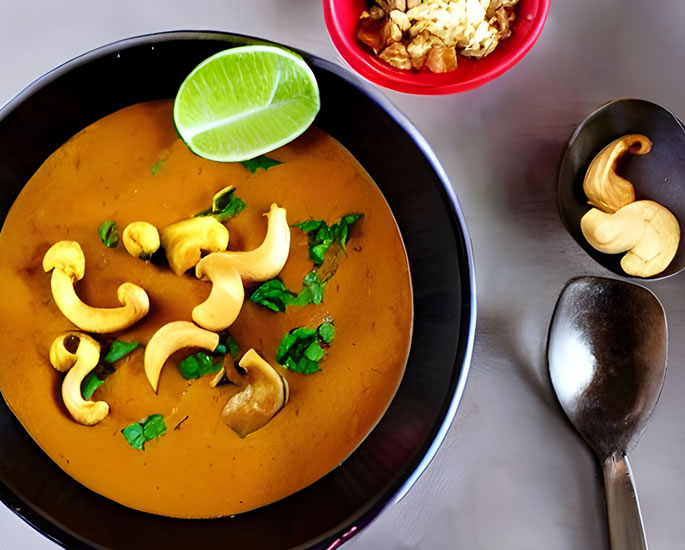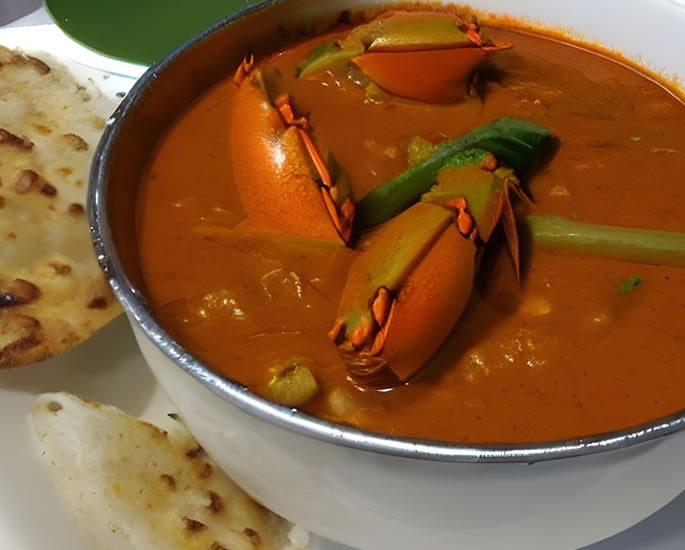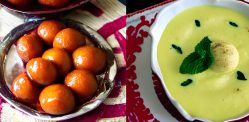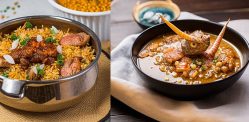The goraka fruit acts as a natural preservative
There is a variety of Sri Lankan foods which boast flavour but how do some of them look through the use of AI?
Artificial intelligence has become a prominent creation tool in both a written and visual sense.
Although there are popular Sri Lankan dishes, we wanted to see how they turn out using an AI tool.
Using AI image generators, we created images of popular Sri Lankan foods to see how accurate their depictions are as well as the different presentations of classic dishes.
Ambul Thiyal
Also known as Sour Fish Curry, this traditional dish is known for its tangy and spicy taste.
Firm fish such as tuna is typically cut into cubes and marinated in a blend of spices before being cooked.
The marinade consists of a combination of ground black pepper, dried goraka (a fruit similar to tamarind), fenugreek seeds, turmeric powder and salt.
This mixture gives Ambul Thiyal its distinctive sour and slightly spicy flavour.
To prepare Ambul Thiyal, the marinated fish is cooked in a clay pot with a small amount of water.
The dish is traditionally slow-cooked over a low flame, allowing the flavours to develop and the fish to absorb the tangy marinade.
The goraka fruit acts as a natural preservative and souring agent, infusing the fish with its unique taste.
The cooking process results in tender and succulent fish pieces with a rich, dark brown colour.
The gravy that forms during cooking is thick and intensely flavoured, with hints of sourness from the goraka and subtle spiciness from the black pepper.
Kaju Maluwa
This flavourful Sri Lankan dish features cashew nuts as the star ingredient.
They are cooked in a rich and aromatic spice blend, resulting in a savoury and slightly creamy dish.
The preparation typically involves sautéing the cashews in a combination of spices and other ingredients to enhance their flavour.
Oil or ghee is heated in a pan before chopped onions, garlic and ginger are added.
These aromatics are cooked until they turn golden and fragrant, releasing their flavours into the dish.
Then, a mixture of ground spices such as turmeric, curry powder, and chilli powder is added to the pan, creating a vibrant and aromatic base.
Once the spices are well incorporated, the cashew nuts are added to the pan and coated with the spice mixture.
To bring out the creaminess in the dish, coconut milk is often added to the pan. The cashew nuts are simmered in the coconut milk until they become tender and infused with the flavours of the spices and coconut.
Some variations of Kaju Maluwa may also include other vegetables like green peas or potatoes for added texture and flavour.
Crab Curry
In coastal areas of Sri Lanka, Crab Curry is immensely popular.
To prepare crab curry, fresh crabs are typically used. The crabs are cleaned, washed and prepared by removing the top shell, apron and gills.
The remaining crab pieces, including the claws and legs, are then used in the curry.
It is made by sautéing a mixture of finely chopped onions, garlic, ginger, and green chillies in oil until they become fragrant and golden.
A blend of spices, such as turmeric, chilli powder, coriander and cumin, is added to the pan, creating a rich and aromatic spice paste.
The crab pieces are then added. Coconut milk is often added to the curry to create a creamy and flavorful sauce. The crab is then simmered in the coconut milk until it becomes tender and infused with the spices.
The final result is a luscious and aromatic crab curry with a rich, thick gravy, making it undoubtedly a highlight of Sri Lankan cuisine.
Kottu
Kottu is a popular Sri Lankan street food dish that is both delicious and visually captivating.
The preparation of kottu starts with roti, which is torn or cut into small pieces.
It is then combined with a variety of vegetables such as onions, carrots, leeks and cabbage. Additional ingredients like eggs, chicken, beef, or seafood can also be added, making it a versatile dish.
It is traditionally cooked on a flat griddle and the chef uses two metal blades to chop and mix the ingredients on the hot surface.
This chopping technique breaks down the roti into smaller, bite-sized pieces and combines them with the other ingredients, allowing the flavours to combine.
Spices and sauces are added at the same time.
This typically includes curry powder, turmeric, chilli flakes, garlic, ginger and various condiments like soy sauce and tomato sauce.
The final result is a fragrant and colourful medley of textures and tastes.
Gotukola Sambola
This Sri Lankan salad features the nutritious herb known as Gotu Kola, which is believed to have antioxidant properties and is considered to be beneficial for digestion and overall well-being.
The preparation of Gotukola Sambola typically involves finely chopping or shredding the Gotu Kola leaves.
Other ingredients are then added to enhance the flavour and texture. These can include grated coconut, red onions, green chillies, lime juice and sometimes Maldive fish (a type of cured and dried fish).
Once all the ingredients are combined, they are mixed together thoroughly.
The lime juice adds a tangy and citrusy element, while the coconut provides a creamy and slightly sweet taste. The combination of flavours creates a delightful balance in the salad.
This popular Sri Lankan food is often served alongside rice and curry.
Parippu
Parippu is a staple in Sri Lankan cuisine. It is a flavourful and nutritious curry cooked in a blend of spices and coconut milk.
Preparation begins with rinsing and boiling lentils until they become soft and mushy.
In a separate pan, a mixture of aromatic spices such as curry leaves, mustard seeds, cumin seeds and dried red chilli peppers is sautéed in oil or ghee until they release their flavour.
Finely chopped onions, garlic and ginger are added to the spice blend.
After coconut milk and water is added, the result is a thick and hearty lentil curry.
Because the lentils break down during cooking, the curry has a smooth and creamy texture while the spices and coconut milk provide a flavorful and fragrant taste.
Parippu is commonly served alongside steamed rice or with roti.
Wambatu Moju
This Sri Lankan food is known for its sweet, sour and spicy flavours.
The preparation of Wambatu Moju typically involves slicing aubergine into long strips. The aubergine slices are then deep-fried until they become golden and crispy, imparting a delightful texture to the dish.
After frying, the aubergine is set aside, and a sweet and sour marinade is prepared. The marinade usually consists of vinegar, sugar, water, mustard seeds, turmeric, chilli powder and sometimes sliced onions.
The mixture is heated and brought to a simmer, allowing the flavours to meld together.
Once the marinade is ready, the fried aubergine slices are added to the sauce, ensuring they are coated well. The dish is then left to marinate for several hours or overnight, allowing the aubergine to absorb the flavours and become infused with the tangy and spicy marinade.
This delicious side dish is often served alongside rice and curry to balance out the flavours.
Sri Lankan foods have layers of flavour which is why they remain popular.
Through the use of AI, their depictions were impressive.
While some images were impressive recreations, others differ slightly away from the original dish.
Nevertheless, it showcases how impressive AI currently is and how versatile it is when it comes to dealing with different subjects such as food.




































































